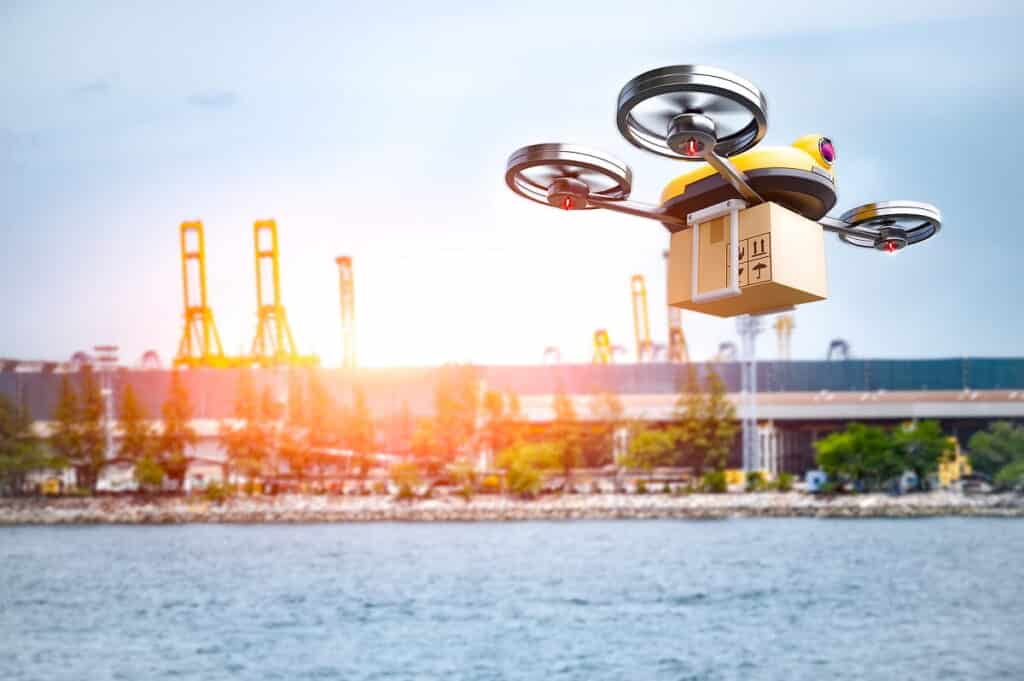How Autonomous Drone Flights Will Go Beyond Line of Sight
Table of contents
Table of contents

This is the time of year where we make wild predictions about what’s going to happen in the coming 12 months of the new calendar year. It’s exactly like astrology except that we use chicken bones and goat’s blood MBA-powered research to back up our claim. In this article, we want to talk about how autonomous drone flights for delivery and industrial services will finally take off into the wild blue yonder. In other words, the shackles of government regulation will finally loosen – or, more accurately, will finally be fully in place – to allow widespread drone usage beyond visual line of sight (BVLOS). It’s been the Holy Grail of the drone industry for years: The ability to fly drones autonomously without human observation or beyond a designated air zone for commercial purposes.
The latest step forward came from the Federal Aviation Administration (FAA) just a few days ago when the agency issued its proposed rules on remote identification of drones. Basically, the regulation would require drones larger than 0.55 pounds to transmit identification codes and location – a sort of digital license, as others have referred to it – so that authorities can track what’s flying where. Drone manufacturers have three options for compliance (a process that’s expected to take years to complete):

The move is seen as an important step to integrate drones into a futuristic urban air mobility scenario where autonomous drones, flying cars, and other airborne contraptions engage in an AI-orchestrated aerial acrobatic dance like something out of Blade Runner.
BVLOS Operations Take Off with FAA Approval
A lot of regulatory and technical work remains for that to become a reality, but a number of companies have put in the legwork in 2019 to help make it happen. Both Alphabet (GOOG) and Amazon (AMZN) have moved forward this year with their grand plans for drone delivery services. However, Alphabet (aka Google) has the upper hand between the two tech giants, as Google Wing received FAA certification to use drones for delivery with a pilot who must still fly within visual line of sight. However, package delivery company UPS (UPS) scored FAA approval for BVLOS operations for its Flight Forward subsidiary that come with few restrictions other than those rules that already exist for commercial air carriers. The company has already proved the technology in the healthcare sector where it transports supplies for hospital campuses.
This year marked another FAA-approved first for BVLOS operations when a drone conducted a nearly four-mile inspection along a stretch of oil pipeline in Alaska. While the University of Alaska managed the pilot program, the technology actually came from a trio of startups. San Francisco-based Iris Automation provided the computer vision technology for the collision-avoidance system, Echodyne out of Bellevue, Washington developed the ground-based radar system to track the operation, and the drone itself came from Skyfront, a Silicon Valley manufacturer of long-range, hybrid-electric drones.

Founded in 2015 and with $10 million in disclosed funding, Iris Automation went even further in Kansas in a project with the state’s Department of Transportation and Kansas State University. The company’s detect-and-avoid system, an AI-platform called Casia, enabled a fixed-wing drone to complete more than 150 miles of power line inspections flying BVLOS over two days in November. The operation reportedly marked the first BVLOS autonomous drone flight under the FAA’s small unmanned aircraft system rules, also known as Part 107, that didn’t require visual observers or ground-based radar.
Update 12/15/2020: Iris Automation has raised $13 million in Series B funding to improve and extend its technology. This brings the company’s total funding to $23 million to date.
Business Case for Autonomous Drone Flights BVLOS
Of course, that’s Kansas, so there’s not too much to hit aside from grain silos. Still, it’s an impressive achievement, considering that 99% of Part 107 waivers submitted to the FAA are turned down, according to PrecisionHawk, one of the most well-funded drone startups out there. It’s also one of the companies that has been leading the industry charge for BVLOS drone flights, and its CEO, Michael Chasen, is also currently chairman of the FAA’s Drone Advisory Committee.
Founded about 10 years ago, the Raleigh, North Carolina startup raised an additional $32 million this month since we last covered the company in our article on agriculture imaging solutions. The company has raised a total of $136 million from a diverse cast of investors, including global ag companies Syngenta and DuPont, as well as Comcast (CMCSA), among others. Last year, the company introduced an autonomous drone flight platform for BVLOS operations, the culmination of three years of research.

PrecisionHawk has also been doing its homework for presenting the business case for BVLOS flights. For example, high-tension power lines must be inspected on a regular basis, an operation that usually requires a manned helicopter that can cost anywhere from $40-$700 per mile. An autonomous drone can do the same work for roughly $10 to $25 per mile, according to PrecisionHawk, which estimates that a company inspecting 10,000 miles of power lines a year could save $1.7 million in the first year of operation alone.
Autonomous Drone Flight Startups Raising Money in 2019
In addition to PrecisionHawk, a ton of other startups have raised funding in 2019 for various technologies and platforms that enable autonomous drone flights that could one day help power BVLOS deliveries or commercial services. We’ve covered quite a few of them previously, such as San Francisco-based DroneDeploy, which picked up an additional $35 million last month to bring total funding up to $91 million. There’s also drone delivery startups Volans-i and Flytrex. The former raised $20 million in May for $25.1 million in total funding, while the latter grabbed $8 million at the beginning of the year for $11 million in total funding. Drone air traffic control startups Airmap and Unifly also both took funding this year. Airmap raised an undisclosed round in May, while Belgium’s Unifly flew off with about $19 million in July, with total funding at $26 million.
For the remainder of this article, we want to briefly profile four additional autonomous drone startups that received fresh funding in 2019 that we have not previously covered.
Drone Inspection for the Energy Sector


In 2018, the company conducted more than 46,000 flight operations and inspected more than 200,000 infrastructure assets, mainly for the energy sector.
Autonomous Drone in a Box
Founded in 2014, Percepto is an Israeli startup also focused mainly on the energy sector. It has raised $27.5 million, including a $15 million Series A in May. Not bad for a company that started out as a hobby for its founders. Like many autonomous drone flight startups, Percepto’s secret sauce is in its computer vision technology. Its autonomous drone, Sparrow, nests in a base station until it is called upon to sally forth on a mission.

Percepto builds both the AI-powered software for automated data collection and analysis, as well as the drones themselves.
Autonomous Drone Flights Underground


Perhaps even more impressive, the autonomous drones are able to do edge computing without the need for constant communication, uploading its relevant data after completing each mission.
Autonomous VTOL Drone for Mapping


The company claims the WingtraOne has a range of 30 miles and can map almost twice as much territory as a conventional fixed-wing drone and up to 15 times more than multicopter drones.
Conclusion
Autonomous drones are nothing new, but the increasing complexity of the aerial robots, thanks to continuous improvements in areas of artificial intelligence like computer vision means that we are on the cusp of enabling BVLOS flights on a sci-fi scale. The startups that we have named here are raising respectable rounds with the expectation that drones will soon take over many of the manual inspections, services, and deliveries currently done by humans but at a fraction of the cost.
Sign up to our newsletter to get more of our great research delivered straight to your inbox!
Nanalyze Weekly includes useful insights written by our team of underpaid MBAs, research on new disruptive technology stocks flying under the radar, and summaries of our recent research. Always 100% free.













